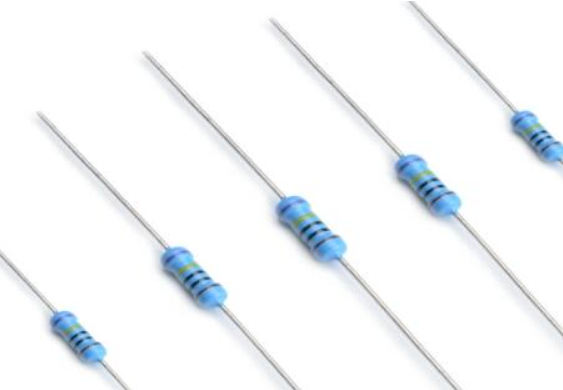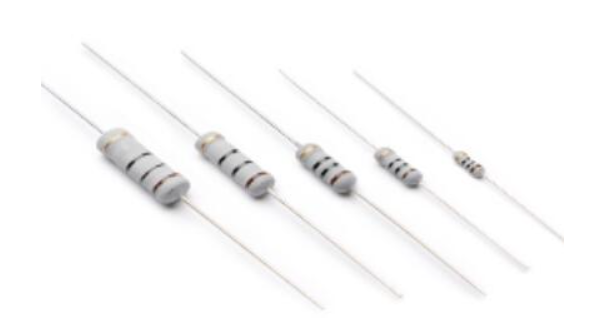Carbon film resistor:
Carbon film resistors used to be the most used resistors in electronics, electrical appliances, and information products, with the cheapest price and high reliability in quality stability. Because it is a leaded resistor, it is convenient for manual installation and maintenance, and it is also the cheapest of the leaded resistors. Now it is mostly used in some low-value low-end products such as power supplies and adapters or early-designed products.
Carbon film resistors are commonly used resistors in the early days. Vacuum spraying technology is used to spray a layer of carbon film on the ceramic rod, and then the outer layer of the carbon film is processed and cut into spiral patterns. The resistance value is determined according to the number of spiral patterns. The more lines there are, the greater the resistance value is. Finally, the outer layer is coated with epoxy resin for sealing protection. Carbon film resistors are still widely used in various products and are the most basic components of current electronics, electrical appliances, equipment, and information products.

Metal film resistance:
Metal film resistors are widely used resistors so far, with high precision, stable performance, simple and lightweight structure. Metal film resistors are resistors in which special metals or alloys are used as resistance materials, and the resistance film layer is basically formed on ceramic or glass by vacuum evaporation or sputtering. This type of resistor is generally made by vacuum evaporation process, that is, heating the alloy in a vacuum, the alloy is evaporated, so that a conductive metal film is formed on the surface of the porcelain rod. The resistance value can be controlled by cutting grooves and changing the thickness of the metal film. Its heat resistance, noise potential, temperature coefficient, voltage coefficient and other electrical properties are better than carbon film resistors.
The manufacturing process of metal film resistors is relatively flexible. Not only can its material composition and film thickness be adjusted, but also the resistance value can be adjusted through grooves. Therefore, a resistor with good performance and a wide resistance range can be made. Compared with carbon film resistors, it has small size, low noise and good stability, but the cost is higher. It is often widely used as a precision and high stability resistor, and it is also commonly used in various radio electronic equipment.

Oxide film resistance:
The metal oxide film is decomposed and deposited by spraying a metal salt solution onto the hot ceramic framework. Its appearance is similar to the resistance of a metal film. It has better oxidation resistance than a metal film and has excellent pulse overload characteristics. Performance, but its resistance range is small, and the temperature coefficient is large.
The resistance range of metal oxide film resistors is 1Ω~200kΩ. This type of resistor is made of hydrolyzable metal salt solutions (such as tin tetrachloride and antimony trichloride) decomposed and deposited on the surface of hot glass or ceramics. . With the different manufacturing conditions, the performance of resistors also vary greatly.
The main feature of metal oxide film resistors is high temperature resistance. The working temperature range is +140~235℃, which can be overloaded in a short time; the temperature coefficient of resistance is ±3×10-4/℃; and the chemical stability is good. The resistance of low-power resistors does not exceed 100 kilohms, so the scope of application is limited, but it can be used to supplement the low-resistance part of metal film resistors.

Winding resistance:
The wire-wound resistor is made of constantan or nickel-chromium alloy resistance wire, wound on a ceramic skeleton. It is characterized by stable work, good heat resistance, and small error range. It is suitable for high-power applications, and the rated power is generally 1 watt. Above. Wirewound resistors have the advantages of high reliability, good stability, no nonlinearity, and small current noise, temperature and voltage coefficient. It is worth noting that wirewound resistors have inductive and capacitive effects and are usually not suitable for Frequency above 50kHz. Due to the skin effect, the resistance of wirewound resistors usually increases with the increase in frequency. Precision fixed wirewound resistors have accurate resistance and very high stability. Power wirewound resistors can withstand more stability. The working voltage is much higher pulse voltage, but it should be derated accordingly in use. In order to ensure the long-term reliability of the circuit, the design should allow wire wound resistors to have a certain resistance tolerance: precision wire wound resistors are ±0.4%; power wire wound resistors are ±1.5%.
The above is the difference between carbon film resistors, metal film resistors, oxide film resistors and wire wound resistors. For more knowledge about resistors, you can leave a message to us, or enter the product center, or leave a message to us.